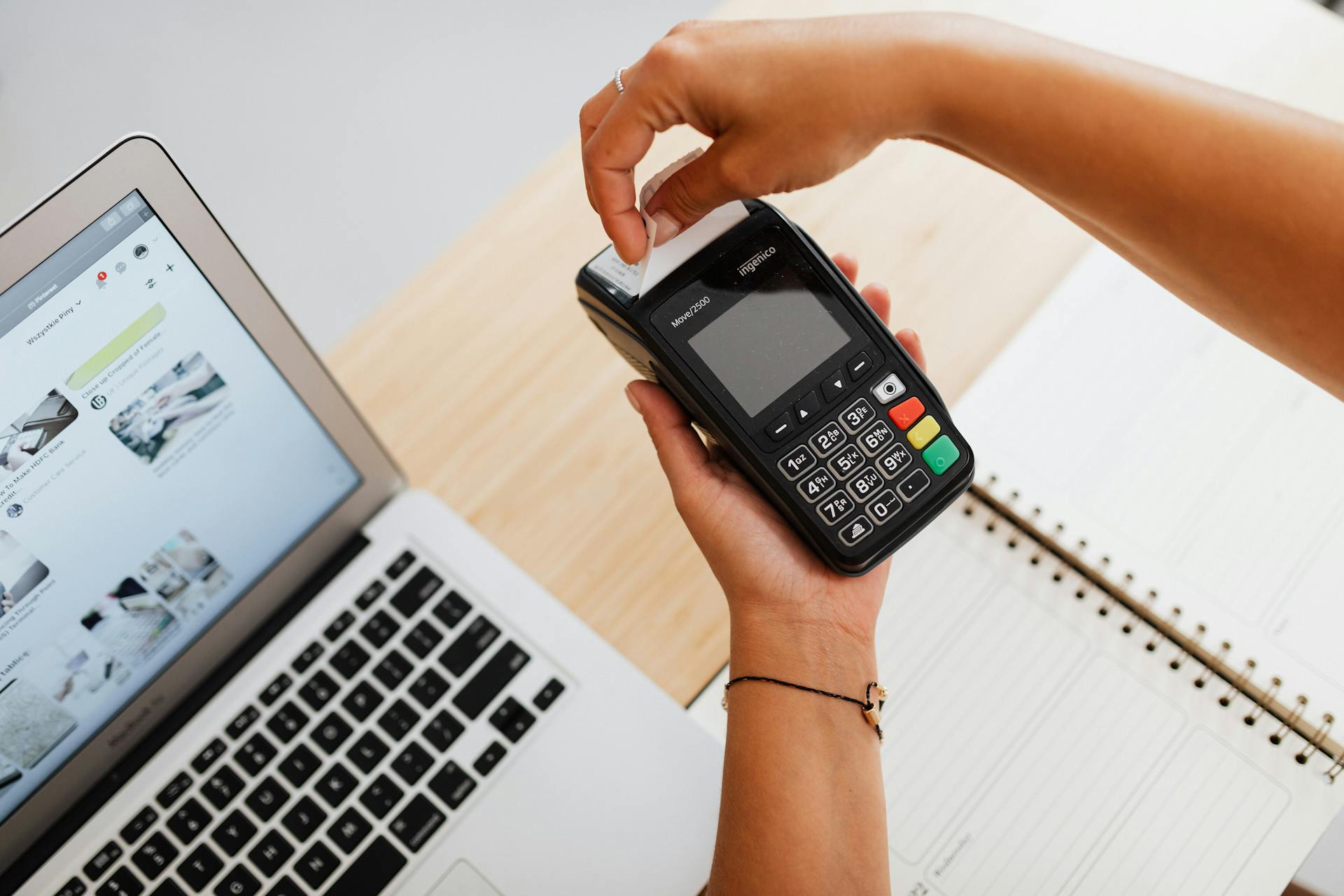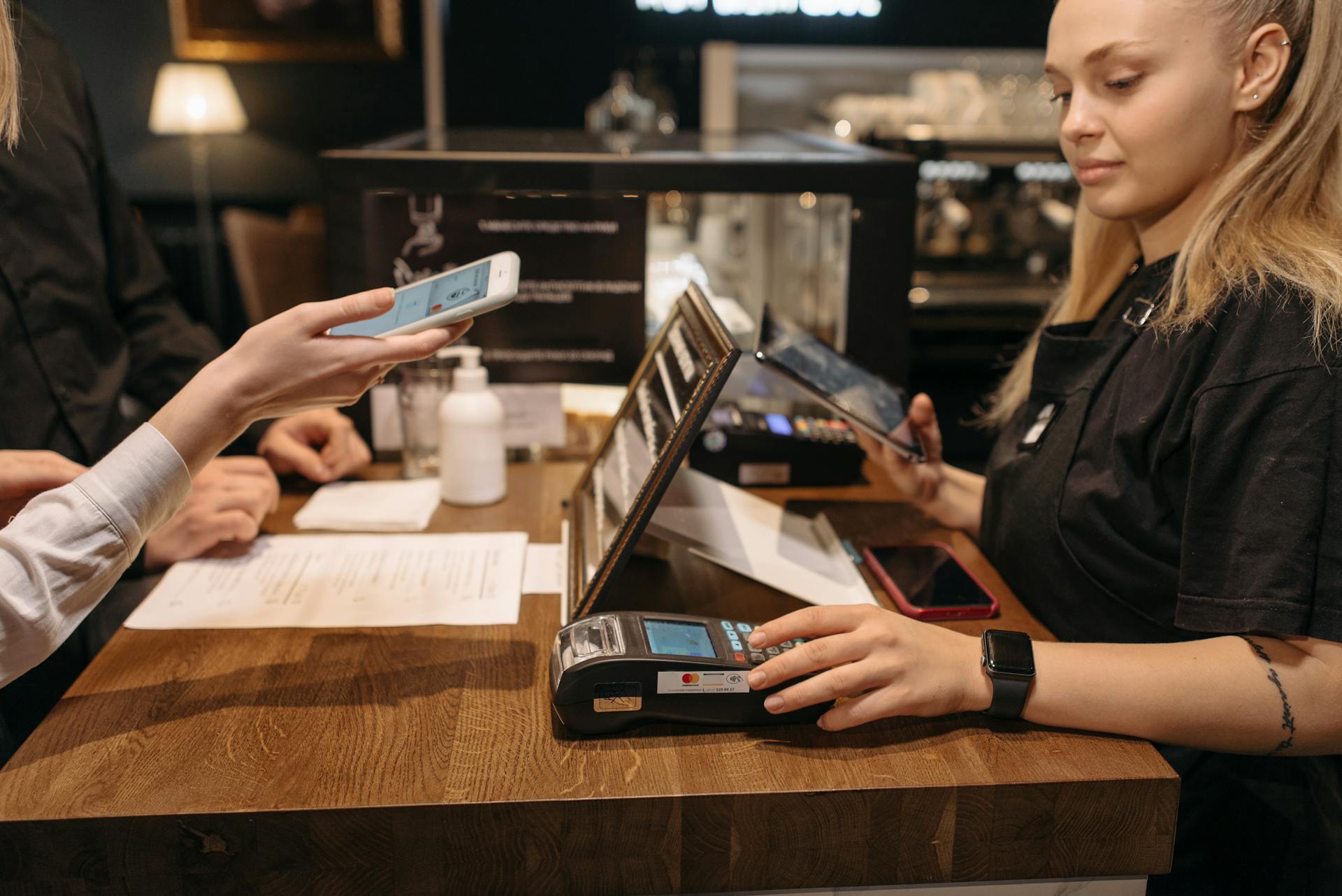
Clear payment terms are essential for building trust with your customers. According to a survey, 75% of businesses consider payment terms when deciding whether to work with a supplier.
Long payment terms can be a major turn-off for customers, with 60% of businesses citing them as a reason for not doing business with a supplier. This highlights the importance of offering flexible payment options that meet the needs of your customers.
Offering a range of payment options, such as net 30 or credit terms, can help to streamline the payment process and improve customer satisfaction. For example, a business that offers credit terms may see a 20% increase in sales due to the increased flexibility offered to customers.
Payment Methods
Payment Methods are a crucial aspect of B2B payment terms. Having a choice of accepted payment options lets your business use its preferred payment method that will provide security at a reasonable cost.
For instance, ACH payments are made through an Automated Clearing House, which acts as an intermediary between bank accounts to complete bank transfers. This method is popular with B2B businesses as it's a contractual payment method, requiring both parties to complete paperwork, making it more secure.
ACH payments are cost-effective, taking up to three days to process and costing around 1% of the transaction with a $10 cap. They're suited to businesses making recurring payments, rather than one-time transactions.
Commercial credit cards are one of the most popular methods of payment from a buyer standpoint, but for the supplier, credit cards are one of the most expensive methods for accepting payments. The associated processing fees can be significant, but many businesses choose to accept credit card payments to avoid losing potential business.
Wire transfers are another option, but they attract processing fees of up to $40 per transaction to send money and up to $15 to receive it. If transactions are being made internationally, those figures go up even higher.
Here are some of the most common B2B payment methods:
- ACH payments
- Commercial credit cards
- Wire transfers
- Cash-in-advance (CIA)
- Letters of credit
- Documentary collections
- Open account
- Consignment
These payment methods can differ depending on the business issuing the invoice, and it's essential to consider the fees and security associated with each option when choosing which ones to accept.
Digital Solutions
Digital Solutions can make a huge difference in B2B payment terms. Digital B2B payment software can solve nearly all the challenges presented by traditional payment methods.
Finance leaders believe their buyers are ready to transition to making payments digitally, which is great news for businesses. This shift enables companies to streamline financial workflows, automate tasks, and gain real-time visibility into cash flows.
Digital payments are processed almost instantly, eliminating long waiting periods and making payment processing faster and more efficient. This is because digital payments are encrypted and protected against fraud, theft, and other security risks.
Here are some key benefits of digital B2B payment methods:
- Faster and more secure payments
- More efficient accounts receivable processes and payments
- Reduced business costs
- Better customer experiences and higher satisfaction
Digitizing
Digitizing your payment processes can be a game-changer for your business. By moving away from traditional paper-based methods, you can streamline financial workflows and automate tasks.
Digital payments enable companies to gain real-time visibility into cash flows. This shift towards digitization is becoming increasingly popular, with more businesses embracing digital payment solutions to reduce costs and improve efficiency.
Self-service payment portals can be a customer-centric initiative that keeps your books organized. These portals allow customers to make payments easily and securely, reducing friction in the payment process.
Digital payments are processed almost instantly, eliminating long waiting periods. This enables businesses to receive payments faster, and customers to make payments more quickly.
Virtual Credit Cards
Virtual credit cards are digitally generated 16-digit numbers that can be used in place of a physical credit card. They have quickly gained popularity from both the seller and buyer side for B2B payments.
Virtual credit cards are one of the most secure B2B payment methods because they are typically only used once. Tokenization and spend controls make them a great option.
Controls can be implemented on virtual credit card numbers to limit their use based on parameters like type of purchases, length of validity, and the dollar amount it can cover. This adds an extra layer of security and flexibility.
There are numerous additional benefits to using virtual credit cards as B2B payment methods, which finance leaders are quick to recognize.
Suggestion: Can't Pay Credit Cards Unemployed
Traditional Challenges
Slow processing times are a major issue with traditional B2B payments, often taking longer than expected and causing frustration for both buyers and sellers.
High transaction fees are another significant problem, making it more costly for sellers to process payments.
Security concerns are also a challenge, particularly when manual processes like checks are involved.
Late payments can have a ripple effect, causing cash flow issues for suppliers and affecting their ability to meet their own financial obligations.
Many B2B payments still rely on manual processes, leading to inefficiencies and human error.
Here are some of the core challenges of traditional B2B payments:
- Slow processing times
- High transaction fees
- Security concerns
- Late payments
- Lack of collaboration
Paper Checks
Paper checks are still a common B2B payment processing method, despite the decline in individual consumer use.
This method is likely due to businesses holding onto outdated practices, but it's worth noting that digital payment methods are the future.
Digitization has forced a shift towards digital B2B payment methods, with a focus on boosting efficiency and transparency.
In fact, digitizing AR processes and embracing B2B payment methods is transforming customer relationships and collaboration between AR and AP teams.
This shift is a result of buyers' continued quest for convenience, which is driving the adoption of digital payment methods.
Check this out: B2b Card Payments
Challenges

Traditional B2B payments have their fair share of challenges. Non-digital payments like paper checks can slow down the payment process, making it less convenient for buyers and more costly for sellers.
High invoice processing expenses are a common consequence of non-automated payments. This can be a significant burden for businesses, eating into their profits.
Slow processing times can lead to late payments, which can cause cash flow issues for suppliers. This can be particularly problematic for businesses that rely on timely payments to stay afloat.
Security concerns are another challenge associated with traditional B2B payments. Manual processes like checks can be vulnerable to fraud, especially when involving large sums of money.
Here are some of the core challenges of traditional B2B payments:
- Slow processing times
- High transaction fees
- Security concerns
- Late payments
- Lack of collaboration
Longer payment cycles are common in B2B transactions, leading to cash flow issues for suppliers. This can be a major headache for businesses, making it difficult to manage their finances.
B2B payments are often more complex than consumer transactions, involving negotiated terms, contracts, and larger sums of money. This can make the payment process more complicated and time-consuming.
Negotiation and Communication
To negotiate better payment terms, consider offering small discounts, such as 2% or 5%, for early payments. For example, you can offer a 5% discount for clients who pay within seven days.
When communicating payment terms, it's essential to clearly outline them in the contract. This is usually written up in legal language, so make sure to include details such as payment schedules, late fees, and the currency to be used.
You can also customize payment terms to accommodate the unique needs of your B2B customers, including flexible payment schedules and discounts for early payments. This can be done with a payments platform that allows you to set and customize payment terms.
Better Customer Experience
In today's digital age, customers expect to be able to make payments online, even for large-scale B2B transactions. This eliminates the need for customers to visit physical locations or make phone calls to submit payments.
Digital B2B payment options offer customers the convenience of making payments from anywhere and at any time. This adds convenience and gives customers more control over their payment processes.
The various digital B2B payment methods available today allow customers to choose the best method for their organization's needs. This builds customer trust and confidence through enhanced security.
By providing customers with digital B2B payment options, businesses can enhance the overall customer experience and build stronger relationships with their clients.
How Do You Communicate?
Communicating payment terms clearly is essential in B2B transactions. You should include payment details in the contract, which is the first place a customer will see and agree to your payment terms.
The contract typically outlines the payment schedule, including when invoices are due and any late fees that may apply. For example, a contract may state that payments are due within 30 days after the date of the invoice, and payments late by seven days will accrue 1% in late fees per month until the invoice is paid.
Adding payment details to an invoice is also common. This can be shown at the top of the invoice, after the payment options, or as part of a separate "terms and conditions" page.
Recommended read: 60 Days in Tv Show Payment Terms
Lack of Collaboration
Traditional B2B payment methods can hinder collaboration among businesses. This is because they often involve manual effort and disconnected systems, making it difficult to work with partners.
Lack of integration between systems is a major issue. It prevents businesses from using modern, digital payment methods with their partners.
Manual payment processes can lead to limited payment data. This might only include the payment amount and date, making it hard to identify which outstanding invoice a payment should be applied to.
Traditional payment methods also lack transparency. This can make it challenging for businesses to collaborate effectively with internal departments and external partners.
Expand your knowledge: What Is Financial Asset Management Systems
Payment Terms and Conditions
Payment terms and conditions are crucial in B2B transactions to ensure timely payments from customers. You can include payment terms on an invoice using standard fields from your accounting software, adding a note clearly wording the due date and any early payment discount offered.
Payment terms include the amount, invoice date, how to pay, payment methods, early payment discount percentage, penalties, and due dates. This information should be clearly stated on the invoice to avoid any confusion.
Recommended read: Discount Payment Terms
To make it easier, you can use a payment term abbreviation such as Net 30, which means the invoice is due for payment by the customer within 30 days of the invoice date. Here are some common payment terms:
By clearly stating your payment terms, you can avoid disputes and ensure timely payments from your customers.
Benefits
Digital B2B payment solutions can solve nearly all the challenges presented by traditional payment methods. By automating digital payment methods, businesses can improve accounts receivable processes and customer experience.
Faster and more secure payments are just one of the benefits of accepting digital B2B payment methods. This is especially true for customers who expect to make payments online, even for large-scale transactions.
Digital B2B payment options offer customers convenience by allowing them to make payments from anywhere and at any time. This eliminates the need for physical locations or phone calls to submit payments.
Reducing business costs is another advantage of digital B2B payment options. Lower processing fees, decreased administrative costs, and quicker payment processing are all benefits associated with digital payments.
Here are some benefits of digital B2B payment solutions:
- Faster and more secure payments
- More efficient accounts receivable processes and payments
- Reduced business costs
- Better customer experiences and higher satisfaction
High Transaction Fees
High transaction fees can be a major headache for businesses. Traditional B2B payment methods like wire transfers and paper checks come with a multitude of fees.
Most of these fees are passed along to the seller, drastically increasing the cost of doing business. This can be a significant burden for small businesses or those with limited budgets.
Processing fees, intermediary fees, and currency conversion fees are all common types of fees associated with traditional payment methods. These fees can add up quickly and eat into profit margins.
Including Payment
Including payment terms on an invoice is crucial for getting paid on time. You can include payment terms using standard fields from your accounting software, add a note clearly wording the due date and any early payment discount offered, add a URL/link to an online payment page on a website, billing department contact information for questions, and other details.
See what others are reading: Can You Add Payments Terms to a Wuickbooks Online Advanced
To make it easy for customers to pay, you can include a link to an online payment page on your website. This allows customers to make payments online, from anywhere and at any time, eliminating the need for physical checks or phone calls.
Payment terms include the amount, invoice date, how to pay, payment methods, early payment discount percentage, penalties, and due dates. This information should be clearly stated on the invoice to avoid confusion.
Some common payment due date terms include Net 30, Net 60, and 2/10 Net 30. Net 30 and Net 60 are the most common payment due date terms with no discount, but you can specify a different due date like Net 10, Net 15, Net 45, or Net 90 instead.
You can also offer early payment discounts to incentivize customers to pay on time. For example, 2/10 Net 30 offers a 2% discount on invoices paid within 10 days of the invoice date.
To ensure timely payment, you can also include a late fee in your payment terms. The average late fee ranges between 1% and 1.5%, and it's best practice to offer a brief "grace period" in case of unanticipated delays.
Discover more: Payment Terms 2 10 Net 30
Here are some common payment terms for payment due dates:
It's essential to clearly define the invoice's issuance date and assign a unique reference to each invoice to facilitate billing tracking and avoid confusion.
Here's an interesting read: Invoice Payment Terms Sample
Costs
Traditional B2B payment methods come with a number of fees that can drastically increase the cost of doing business. These fees include processing fees, intermediary fees, and currency conversion fees, which are often passed along to the seller.
Digital payment methods can save organizations money by reducing staffing costs, lowering processing fees, and decreasing administrative costs. Quicker payment processing is also a benefit associated with digital B2B payment options.
Business-to-consumer payments are usually processed under level 1 data, which includes address verification, card number, and card expiration date. However, B2B business owners may qualify for level 2 and level 3 processing, which come with lower payment processing rates.
To qualify for level 2 and level 3 card processing, businesses must collect extra information from the payer. According to Visa's requirements, level 2 processing requires all level 1 data, sales tax, customer code, and purchase ID. Level 3 processing requires all level 1 and level 2 data, destination country code, shipping costs, order data, VAT information, product code, and item description.
Many commercial cards, including B2B credit cards and corporate cards, qualify for level 2 and level 3 rates due to the additional data registered against them. By adding level 2 or 3 payment processing, businesses can see a real impact from lower interchange rates.
You might like: People with Credit Cards
Payment Processing
Traditional payment methods can significantly slow down the payment cycle, taking several days or even weeks to clear, as seen with checks and wire transfers.
Electronic payment methods, on the other hand, facilitate faster payment cycles for both accounts payable and accounts receivable. This is a game-changer for businesses looking to improve cash flow management.
Real-time payments offer an even more efficient alternative, allowing for instantaneous transfer of funds between trading partners. This acceleration can greatly reduce the risk of late payments and enhance cash flow management.
See what others are reading: Accounts Receivable Cash Flow Statement
Slow Processing Times
Slow processing times can be a real pain point for businesses, especially when it comes to traditional payment methods. Traditional payment methods like checks can take several days or even weeks to clear.
This can lead to time delays and negatively impact cash flow. Wire transfers can take several days to process, which is just as frustrating.
Checks, in particular, are a slow and outdated way to make payments. They require manual handling and processing, which can cause delays.
Electronic payment methods, on the other hand, can facilitate faster payment cycles for both accounts payable and accounts receivable. This can help businesses streamline their payment processes and improve cash flow.
Real-Time
Real-time payments offer an efficient alternative to traditional methods, allowing instantaneous transfer of funds between trading partners.
This acceleration enhances cash flow management and reduces the risk of late payments.
Frequently Asked Questions
What is B2B payment method?
B2B payments involve one business paying another for goods or services supplied, typically through a currency transfer. This complex process is distinct from business-to-consumer transactions.
Sources
- https://www.creditmanagement-tools.com/blog/2023/11/20/how-to-optimize-your-b2b-payment-terms-b574.php
- https://tipalti.com/resources/learn/payment-terms/
- https://www.paystand.com/blog/payment-terms
- https://www.versapay.com/resources/b2b-payments-guide
- https://staxpayments.com/blog/what-is-b2b-payments-processing/
Featured Images: pexels.com


